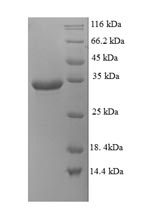Human Probable G-protein coupled receptor 75 Recombinant Protein Product Attributes
Product Type: Recombinant Protein
Recombinant Probable G-protein coupled receptor 75 based upon sequence from Human
Host: QP6113 protein expressed in E.coli, Yeast..
Tag: His-SUMO
Protein Construction: A DNA sequence encoding the Homo sapiens (Human) Probable G-protein coupled receptor 75, was expressed in the hosts and tags indicated. Please select your host/tag option, above.
Recommended Applications: Immunogen, Protein Standard, Cell culture, or Other Cell Biology Applications.
Application Notes: Please contact us for application specific information for QP6113.
Bioactivity Data: Untested
Full Length? Cytoplasmic Domain
Expression Region: Asn372 – Val540
Amino Acid Sequence: NPFIYSRNSA GLRRKVLWCL QYIGLGFFCC KQKTRLRAMG KGNLEVNRNK SSHHETNSAY MLSPKPQKKF VDQACGPSHS KESMVSPKIS AGHQHCGQSS STPINTRIEP YYSIYNSSPS QEESSPCNLQ PVNSFGFANS YIAMHYHTTN DLVQEYDSTS AKQIPVPSV
Purity: Greater than 90% as determined by SDS-PAGE.
Reconstitution Instructions: Concentrated protein in liquid format. Reconstitution is not necessary.
Concentration of Human Probable G-protein coupled receptor 75 Protein:
Endotoxin Levels: Not determined.
Buffer: Tris-based buffer, 50% glycerol
Storage Conditions: Store at -20C to -80C.
| Recombinant Human Probable G-protein coupled receptor 75 Protein General Information | |
|---|---|
| Alternate Names | |
| WI31133, GPRchr2 | |
| Curated Database and Bioinformatic Data | |
| Gene Symbol | GPR75 |
| Entrez Gene ID | 10936 |
| Ensemble Gene ID | ENSG00000119737 |
| RefSeq Protein Accession(s) | NP_006785.1 |
| RefSeq mRNA Accession(s) | NM_006794.3 |
| UniProt ID(s) | O95800 |
| UniGene ID(s) | Hs.40763 |
| HGNC ID(s) | HGNC:4526 |
| COSMIC ID Link(s) | GPR75 |
| KEGG Gene ID(s) | hsa:10936 |
| PharmGKB ID(s) | PA28919 |
| General Description of Recombinant Human Probable G-protein coupled receptor 75 Protein. | |
| G protein-coupled receptor that is activated by the chokine CCL5/RANTES. Probably coupled to heterotrimeric Gq proteins, it stimulates inositol trisphosphate production and calcium mobilization upon activation. Together with CCL5/RANTES, may play a role in neuron survival through activation of a downstream signaling pathway involving the PI3, Akt and MAP kinases. CCL5/RANTES may also regulate insulin secretion by pancreatic islet cells through activation of this receptor. | |
Limitations and Performance Guarantee
This is a life science research product (for Research Use Only). This product is guaranteed to work for a period of two years when stored at -70C or colder, and one year when aliquoted and stored at -20C.




There are no reviews yet.